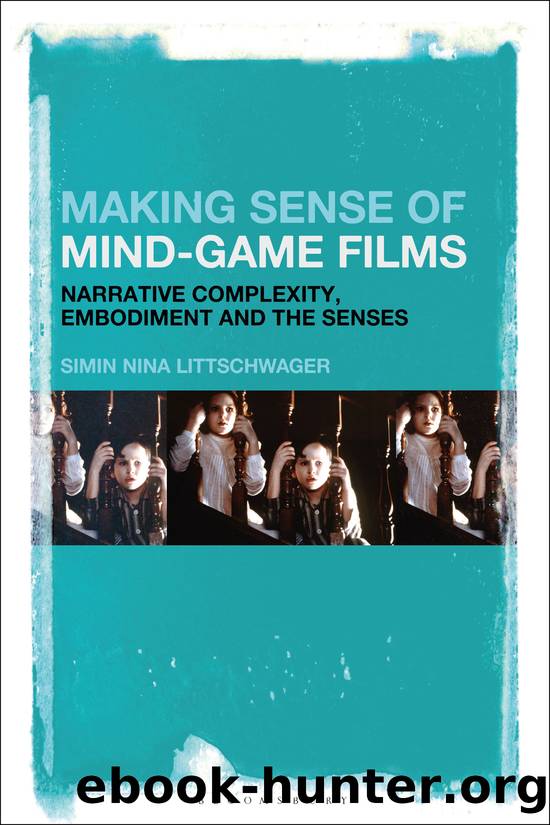Making Sense of Mind-Game Films by Littschwager Simin Nina;

Author:Littschwager, Simin Nina;
Language: eng
Format: epub
ISBN: 9781501337055
Publisher: Bloomsbury USA
Corporeal estrangement and embodied experience in Fight Club
Characterized by aesthetic innovation and narrative hybridity, Fight Club, like many other mind-game films, does not easily fit traditional labels and is hard to place within established genre categories (Ramey 2012: 47).19 Critic Amy Taubin describes it as âan action film thatâs all about interiorityâ (1999: n.p.). But we can also call it the opposite: a mind-game film that is all about exteriority and embodied experience, a film that asks what it means to feel alive and in touch with the world. The most immediately apparent aspects of corporeality in Fight Club are the graphic depictions of sex, violence, and masculinity. Yet Jackâs mental crisis is rooted in a tactile alienation from the world that reaches down to the bodily depths of his entire self, and the film is interspersed with a wide range of ambiguously affective moments and sensuously charged situations that go beyond what is represented on the narrative surface. Moreover, the two main male characters, Jack and his alter ego Tyler, are not only distinct from each other through their political views and lifestyles but through their contrasting bodily styles and ways of being-in-the-world. The differences between them manifest in the surfaces, textures, and materialities they get close to, the activities and actions they take part in, and the deeper anxieties that drive them or that they are free from. However, it would be a simplified view to say that Tyler personifies lacking aspects of Jackâs life: more than merely embodying an opposite way of life, he also allows Jack to inhabit the world in ways other than his own and exposes him to new environments and new experiences, often pushing himâand usâout of the comfort zone.
Aside from the representation of bodies on-screen, Fight Clubâs notoriety can also be attributed to its capacity to elicit bodily responses from its audiences. Perhaps the best token of the range of sensations of escalating intensity that Fincherâs film evokes are the ambivalent reviews of the film. At the time of its initial release Fight Club polarized opinions, attracting critical praise as well as âa sack-load of negative and sometimes hysterical critical commentâ to almost equal measures (Ramey 2012: 45). On the one hand, much of the controversy was sparked by the graphic depiction of sex and violence, as well as by Tylerâs morally ambiguous philosophy. Roger Ebertâs much-cited account of Fight Club as a âcheerfully fascist big-star movie,â a âcelebration of violenceâ and âmacho pornâ is exemplary for the way some critics perceived the film as a glorification of male brutality and misogynist behavior (1999: n.p.). Many of the more favorable reviews, on the other hand, often employed body-based metaphors in describing the filmâs aesthetic. They mention, for example, the âblistering, hyper-kinetic styleâ (Smith 2009, quoted in Ramey 2012: 56); the âkinetic style, visceral approachâ and the âmarriage of adrenaline and intelligenceâ (Berardinelli 1999, quoted in Ramey 2012: 57); or call it a âsustained adrenaline rush of a movieâ (Rooney 1999, quoted in Ramey 2012: 58).
Download
This site does not store any files on its server. We only index and link to content provided by other sites. Please contact the content providers to delete copyright contents if any and email us, we'll remove relevant links or contents immediately.
| Coloring Books for Grown-Ups | Humor |
| Movies | Performing Arts |
| Pop Culture | Puzzles & Games |
| Radio | Sheet Music & Scores |
| Television | Trivia & Fun Facts |
The Kite Runner by Khaled Hosseini(4431)
Gerald's Game by Stephen King(3918)
The Perils of Being Moderately Famous by Soha Ali Khan(3782)
Dialogue by Robert McKee(3582)
Story: Substance, Structure, Style and the Principles of Screenwriting by Robert McKee(2984)
The 101 Dalmatians by Dodie Smith(2935)
The Pixar Touch by David A. Price(2739)
Confessions of a Video Vixen by Karrine Steffans(2673)
Fantastic Beasts: The Crimes of Grindelwald by J. K. Rowling(2543)
How Music Works by David Byrne(2525)
Harry Potter 4 - Harry Potter and The Goblet of Fire by J.K.Rowling(2416)
Slugfest by Reed Tucker(2415)
The Mental Game of Writing: How to Overcome Obstacles, Stay Creative and Productive, and Free Your Mind for Success by James Scott Bell(2393)
Wildflower by Drew Barrymore(2117)
Scandals of Classic Hollywood: Sex, Deviance, and Drama from the Golden Age of American Cinema by Anne Helen Petersen(2109)
Casting Might-Have-Beens: A Film by Film Directory of Actors Considered for Roles Given to Others by Mell Eila(2071)
Screenplay: The Foundations of Screenwriting by Syd Field(2056)
Robin by Dave Itzkoff(2005)
The Complete H. P. Lovecraft Reader by H.P. Lovecraft(1976)
